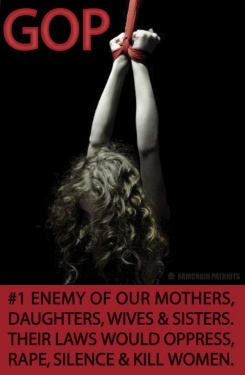
I found the above image on a Facebook page for Americans Against The Tea Party, a contemporary example of virtue in distress/naked (implicitly) bound woman as part of political discourse.
The gallery of images on the Americans Against the Tea Party provide an insight into the less rational side of political discourse. Some of the images make arguments, while other rely on negative associations, and specifically refer to faces and bodies. Sarah Palin and Glenn Beck are likened to apes. Two or three display morbidly obese women as typical “teabaggers”, linking body imagery and misogyny and classism. One pastes Beck’s face onto a slim man in a leatherboy outfit, linking political deviance and sexual deviance, plus likely the cliche of overcompensatory masculinity as a cover for homosexuality. There are also easy cheap shots of juxtaposing right wingers with Nazis or the Ku Klux Klan (two organizations who really knew how to use visual iconography).
These images were presumably created and distributed by left-wing individuals, and I have no doubt that there are comparable images being created and distributed by right-wing individuals. This is a particular level of political discourse, which is very much about the body, and particularly the female body. The image displayed above, separated from the contextualizing text, could be used in other political discourses. A right-winger could use the image of a nude, bound woman to suggest the idea of a woman’s body being confined and interfered with through abortion, decriminalization of prostitution, or other liberal ideas. The image is equally usable.
This image seems to come from a tumblr account, which has a series of lefty political mini-posters. Some of them simply urge the viewer to vote, and uses mild cheesecake (and some beefcake) images to get attention. Others use children-as-victims as motivating devices.
Another image shows a bound woman, though her expression indicates angry defiance, not victimization. The art style suggests the image was recycled from some earlier conflict, indicating the timelessness of this image.
One of the images explicitly shows a woman bound, with the caption, “There’s no safeword with the GOP”, which uses the idea of consensual BDSM as a contrast to what happens between women and the right wing social agenda. (It’s in an image display Flash app, so I can’t link to it.)
As we’ve discussed before, the sexual, and particularly female sexual victimization, has been used in all kinds of political discourse: for and against Atlantic slavery, the Greek rebellion, the German invasion of Belgium in WWII, the Stalag novels, PETA’s ad campaign, and on and on. What’s interesting is that these images linger on well after the conflict that inspired them becomes irrelevant, or at least less relevant. They become detached from political discourse and become solely sexual, part of pornographic discourse.
Addendum: by chance, I came across a book in the erotica section that had a variation of the same image on the cover, Playing by Melanie Abrams, Black Cat, 2008.

